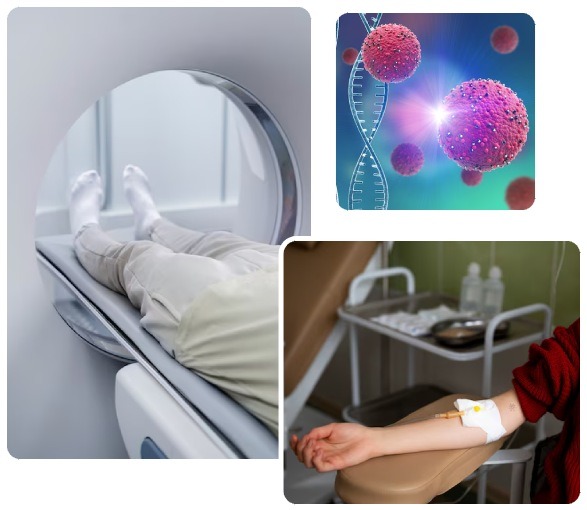Gastrointestinal Cancer

Gastrointestinal Cancer Doctor in Kolkata

Symptoms of Gastrointestinal Cancer
Abdominal Pain or Discomfort
Changes in Bowel Habits
Unexplained Weight Loss
Difficulty Swallowing
Trouble swallowing (dysphagia), particularly in cancers affecting the oesophagus or stomach.
Nausea or Vomiting
Fatigue
Loss of Appetite
Blood in Stool or Vomit
Jaundice
Bloating or Gas
Causes of Gastrointestinal Cancer
Genetic Factors
Diet and Lifestyle
-
High-fat and processed foods:
Diets high in red or processed meats and low in fibre have been linked to an increased risk of colorectal and other GI cancers.
-
Alcohol consumption:
Heavy drinking is associated with cancers of the oesophagus, stomach, liver, and pancreas.
-
Smoking:
Tobacco use is a significant risk factor for many types of GI cancers, including oesophagal, stomach, and pancreatic cancers.
Obesity
Chronic Inflammation
Infections
- Helicobacter pylori infection is a major risk factor for stomach cancer.
- Hepatitis B or C infection increases the risk of liver cancer.
- Human papillomavirus (HPV) is associated with certain types of anal cancer.
Ageing
Exposure to Chemicals and Toxins
Long-term exposure to harmful chemicals, including certain pesticides, asbestos, or toxins, can increase the risk of liver and gastrointestinal cancers.
Pre-existing Conditions
- Gastroesophageal reflux disease (GERD) can increase the risk of oesophagal cancer.
- Diabetes has been linked to an increased risk of pancreatic and liver cancers.

Stages of Gastrointestinal Cancer
Stage 0 (Carcinoma in Situ)
-
Description:
This is the earliest stage where abnormal cells are found only in the innermost layer of the affected organ’s lining.
-
Characteristics:
The cancer has not invaded deeper tissues or spread to other parts of the body.
-
Prognosis:
Highly treatable and often curable.
Stage I
-
Description:
The tumour has begun to invade the deeper layers of the organ’s wall but has not spread to nearby lymph nodes or distant sites.
-
Characteristics:
Confined to the primary site, such as the stomach, colon, or oesophagus.
-
Treatment:
May involve chemotherapy or radiation.
Stage II
-
Description:
The tumour has grown deeper into the organ’s wall and may have spread to nearby tissues but not to the lymph nodes or distant organs.
-
Characteristics:
Larger or more invasive tumours, but no distant spread.
-
Treatment:
Usually requires a combination of chemotherapy or radiation.
Stage III
-
Description:
The cancer has spread to nearby lymph nodes but has not yet metastasized to distant organs.
-
Characteristics:
Larger tumours that may invade surrounding tissues or lymph nodes, but no distant metastasis.
-
Treatment:
Often treated by chemotherapy and/or radiation to target any remaining cancer cells.
Stage IV
-
Description:
The cancer has spread (metastasized) to distant organs such as the liver, lungs, or bones.
-
Characteristics:
Advanced cancer that is no longer confined to the primary organ or nearby lymph nodes.
-
Treatment:
Treatment focuses on controlling the spread of the disease and relieving symptoms. Options include chemotherapy, targeted therapy and immunotherapy.
Recurrent Cancer
-
Description:
Cancer that has returned after treatment, either in the original location or in another part of the body.
-
Treatment:
May involve chemotherapy, radiation or targeted therapy depending on the location and extent of the recurrence.

Types of Gastrointestinal Cancer
Stomach (Gastric) Cancer
- Develops in the lining of the stomach.
- Adenocarcinoma is the most common type.
- Risk factors include Helicobacter pylori infection, smoking, and diets high in salty, smoked foods.
Esophageal Cancer
- Affects the oesophagus, the tube that carries food from the throat to the stomach.
- Types: Squamous cell carcinoma and adenocarcinoma.
- Risk factors include smoking, heavy alcohol use, and gastroesophageal reflux disease (GERD).
Colorectal Cancer
- Affects the colon and rectum, the lower parts of the digestive tract.
- Often starts as polyps that can become cancerous over time.
- Risk factors include a diet low in fibre, high in red and processed meats, and a family history of the disease.
Pancreatic Cancer
- Begins in the pancreas, an organ that aids digestion and regulates blood sugar.
- Pancreatic adenocarcinoma is the most common form.
- Risk factors include smoking, diabetes, chronic pancreatitis, and family history.
Liver Cancer
- Primary liver cancer, also known as hepatocellular carcinoma (HCC), starts in the liver cells.
- Risk factors include chronic hepatitis B or C infections, cirrhosis, and long-term alcohol abuse.
Gallbladder and Biliary Tract Cancer
- Affects the gallbladder and bile ducts, which are part of the biliary system responsible for bile transport.
- Risk factors include gallstones, chronic inflammation, and certain infections.
Small Intestine Cancer
- Rare cancer that affects the small intestine, which absorbs nutrients from food.
- Types include adenocarcinoma, sarcoma, neuroendocrine tumours, and lymphoma.
- Risk factors include Crohn’s disease and a high-fat diet.
Rectal Cancer
- A type of colorectal cancer that specifically affects the rectum, the last section of the large intestine.
- Similar risk factors to colon cancer, including diet, age, and family history.
Anal Cancer
- Occurs in the anal canal, the opening at the end of the digestive tract.
- Most cases are squamous cell carcinoma.
- Risk factors include human papillomavirus (HPV) infection and a history of smoking.
Gastrointestinal Stromal Tumours (GIST)
- Rare tumours can occur anywhere in the GI tract but most commonly in the stomach or small intestine.
- These tumours arise from specialised cells in the GI tract wall.
- GISTs are often driven by mutations in genes.
Diagnosis of Gastrointestinal Cancer
Medical History and Symptoms Review
- The doctor will ask about your symptoms, including any abdominal pain, changes in bowel habits, weight loss, or other GI-related issues.
- A thorough medical history, including family history of GI cancers, previous medical conditions, and lifestyle factors (such as diet, smoking, and alcohol use), is important for assessing risk.
Physical Examination
- A physical examination may be conducted to check for signs of GI cancer, such as abdominal tenderness, masses, or enlarged lymph nodes.
- The doctor may also assess for signs of jaundice, which can indicate liver or biliary tract issues.
Imaging Studies
-
X-rays:
Used less frequently, but can help identify blockages or abnormalities in the GI tract.
-
Ultrasound:
Uses sound waves to create images of the organs and can help detect tumours in the liver or gallbladder.
-
Computed Tomography (CT) Scan:
Provides detailed cross-sectional images of the abdomen, helping to identify tumours, their size, and any potential spread to nearby organs or lymph nodes.
-
Magnetic Resonance Imaging (MRI):
Useful for assessing tumours in specific organs like the liver or rectum and evaluating surrounding tissues.
-
Positron Emission Tomography (PET) Scan:
Often combined with CT, this imaging study can help identify cancer that has spread to distant organs by highlighting areas of high metabolic activity.
Laboratory Tests
-
Blood Tests:
-
Routine blood tests:
They may help assess liver function and detect any abnormalities that could indicate cancer.
-
Tumour markers:
Specific markers for liver cancer may be measured to assist in diagnosis and monitoring treatment response.
-
-
Stool Tests:
Faecal occult blood tests can help detect blood in the stool, which may indicate colorectal cancer.
Endoscopy Procedures
-
Esophagogastroduodenoscopy (EGD):
A flexible tube with a camera is inserted through the mouth to visualise the oesophagus, stomach, and duodenum, allowing for direct examination and biopsy of any suspicious lesions.
-
Colonoscopy:
A similar procedure where a flexible tube is inserted through the rectum to visualise the colon and rectum. If polyps or abnormal areas are found, biopsies can be taken.
-
Endoscopic Ultrasound (EUS):
It combines endoscopy and ultrasound to assess the layers of the GI tract and surrounding structures, providing detailed images and allowing for guided biopsies.
Biopsy
- A biopsy involves removing a small sample of tissue from a suspicious area for laboratory analysis.
- The biopsy is crucial for confirming a cancer diagnosis, determining the type of cancer, and assessing the grade (how aggressive the cancer cells are).


Treatments of Gastrointestinal Cancer
Chemotherapy
Radiation Therapy
Targeted Therapy
Immunotherapy
Endoscopic Treatments
-
Endoscopic Mucosal Resection (EMR):
Removing early-stage cancers from the digestive tract lining.
-
Endoscopic Submucosal Dissection (ESD):
A more complex technique for larger lesions.
Frequently Asked Questions
What are the symptoms of upper gastrointestinal tract cancer?
What is the most common cancer of the gastrointestinal tract?
The most common cancer of the gastrointestinal tract is colorectal cancer, which includes cancers of the colon and rectum. It often develops from polyps in the lining of the colon or rectum.



